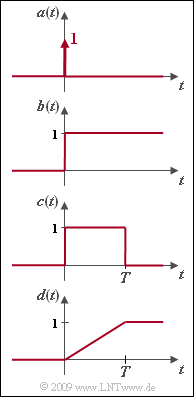Exercise 3.2Z: Laplace and Fourier
The Fourier transformation can be applied to any deterministic signal $x(t)$. Then, the following holds for the spectral function:
- $$X(f) = \int_{-\infty}^{ +\infty} { x(t) \hspace{0.05cm}\cdot \hspace{0.05cm} {\rm e}^{-{\rm j}\hspace{0.05cm}\cdot \hspace{0.05cm}2\pi f t}}\hspace{0.1cm}{\rm d}t\hspace{0.05cm}\hspace{0.05cm} .$$
For power-limited signals – characteristics: infinite energy – $X(f)$ also includes distributions (Dirac delta functions).
For all causal signals (and only for these), the Laplace transformation is also applicable beside the Fourier transformation:
- $$X_{\rm L}(p) = \int_{0}^{ \infty} { x(t) \hspace{0.05cm}\cdot \hspace{0.05cm} {\rm e}^{-p t}}\hspace{0.1cm}{\rm d}t\hspace{0.05cm}\hspace{0.05cm} .$$
In the diagram you can see several causal time functions that will be covered in this exercise:
- the Dirac delta function $a(t)$,
- the unit step function $b(t)$,
- the rectangular function $c(t)$,
- the ramp function $d(t)$.
The Fourier transform theorems usually (though not always) also apply to the Laplace transformation where $p ={\rm j} \cdot 2 \pi f$ is to be set:
- For example, the shifting theorem in Laplace or Fourier representation is:
- $$x(t- \tau) \quad \circ\!\!-\!\!\!-^{\hspace{-0.25cm}\rm L}\!\!\!-\!\!\hspace{-0.05cm}\bullet\quad X_{\rm L}(p)\cdot {\rm e}^{-p \hspace{0.05cm} \cdot \hspace{0.05cm}\tau}\hspace{0.05cm} ,$$
- $$x(t- \tau) \quad \circ\!\!-\!\!\!-^{\hspace{-0.05cm}}\!\!\!-\!\!\hspace{-0.05cm}\bullet\quad X(f)\cdot {\rm e}^{-{\rm j}\hspace{0.05cm} \cdot \hspace{0.05cm}2\pi f \hspace{0.05cm} \cdot \hspace{0.05cm}\tau}\hspace{0.05cm} .$$
- In contrast, there are differences in the integration theorem :
- $$\int {x(\tau)} \hspace{0.1cm}{\rm d}\tau \quad \circ\!\!-\!\!\!-^{\hspace{-0.25cm}\rm L}\!\!\!-\!\!\hspace{-0.05cm}\bullet\quad X_{\rm L}(p)\cdot \frac{1}{p}\hspace{0.05cm} ,$$
- $$\int {x(\tau)} \hspace{0.1cm}{\rm d}\tau \quad \circ\!\!-\!\!\!-^{\hspace{-0.05cm}}\!\!\!-\!\!\hspace{-0.05cm}\bullet\quad X(f)\cdot \left [ {1}/{2} \cdot{\rm \delta } (f) + \frac{1}{{\rm j} \cdot 2\pi f} \right ] \hspace{0.05cm} .$$
Please note:
- The exercise belongs to the chapter Laplace Transform and p-Transfer Function.
- The (German language) learning video "Gesetzmäßigkeiten der Fouriertransformation" ⇒ "Fourier transform theorems" might be helpful.
Questions
Solution
- Considering that the Dirac delta function is non-zero only at $t= 0$ and that the integral over the Dirac delta function yields the value $1$ as long as the integration interval includes the time $t= 0$, the following is obtained:
- $$A(f) = 1, \hspace{0.2cm}A_{\rm L}(p) = 1 \hspace{0.05cm} .$$
(2) Suggested solutions 1 and 3 are correct again:
- The step function $b(t) = \gamma(t)$ is the integral over the Dirac delta function $a(t) = \delta(t)$ ⇒ the integration theorem can be applied:
- $$b(t) = \int_{-\infty}^t {a(\tau)} \hspace{0.1cm}{\rm d}\tau \hspace{0.3cm}\Rightarrow \hspace{0.3cm} B_{\rm L}(p) =A_{\rm L}(p)\cdot {1}/{p} = {1}/{p}\hspace{0.05cm} ,$$
- $$B(f) = A(f)\cdot \left [ {1}/{2} \cdot{\rm \delta } (f) + \frac{1}{{\rm j} \cdot 2\pi f} \right ] = {1}/{2} \cdot{\rm \delta } (f) + \frac{1}{{\rm j} \cdot 2\pi f}\hspace{0.05cm} .$$
(3) Suggested solutions 2 and 3 are correct:
- Since the (causal) rectangular function can be represented as the difference of two step functions, the shifting theorem yields:
- $$c(t)= b(t) - b(t-T) \hspace{0.3cm} \Rightarrow \hspace{0.3cm} C_{\rm L}(p) =B_{\rm L}(p)- B_{\rm L}(p) \cdot {\rm e}^{-p \hspace{0.05cm} \cdot \hspace{0.05cm}T} = {1}/{p} \cdot \big [ 1- {\rm e}^{-p \hspace{0.05cm} \cdot \hspace{0.05cm}T} \big ] \hspace{0.05cm} .$$
- The following holds for the Fourier spectrum since the rectangular function has finite energy:
- $$C(f) = C_{\rm L}(p)\Bigg |_{\hspace{0.1cm} p\hspace{0.05cm}=\hspace{0.05cm}{\rm j \hspace{0.05cm}2\pi \it f}} = \frac{1}{{\rm j} \cdot 2\pi f} \cdot \big [ 1- {\rm e}^{-{\rm j} \hspace{0.05cm}\cdot \hspace{0.05cm} 2\pi f T} \big ] \hspace{0.05cm}.$$
- The following can also be written for this using some trigonometric transformations:
- $$C(f) = T \cdot {\rm si} (2 \pi f{T})+ {\rm j} \cdot \frac{{\rm cos} (2 \pi f{T})-1}{2\pi f} \hspace{0.05cm}.$$
(4) Suggested solution 1 is correct because the following holds:
- $$d(t) = \frac{1}{T} \cdot \int\limits_{-\infty}^t {c(\tau)} \hspace{0.1cm}{\rm d}\tau \hspace{0.3cm}\Rightarrow \hspace{0.3cm} D_{\rm L}(p) =C_{\rm L}(p)\cdot \frac{1}{p \cdot T} = \frac{1- {\rm e}^{-p \hspace{0.05cm}\cdot \hspace{0.05cm}T}}{p^2 \cdot T}\hspace{0.05cm} .$$
- Since $d(t)$ extends to infinity, the simple relation between $D_{\rm L}(p)$ and $D(f)$ according to proposed solution 3 is not valid.
- $D(f)$ rather also includes a Dirac delta function at frequency $f = 0$.
